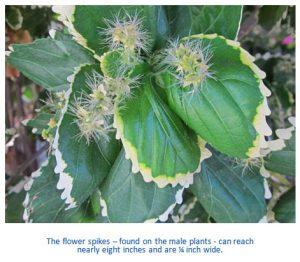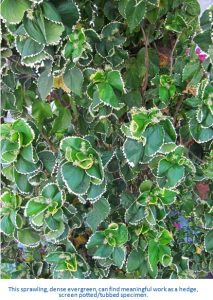By Tommy Clarkson from the June 2017 Edition
Beefsteak Plant Acalypha wilkesiana
Family: Euphorbiaceae
Also known as: Joseph’s Coat, Copper Leaf, Copper Plant or Match-Me-If-You-Can Fijian Fire Plant, Fire Dragon Plant or Redleaf
(This seems to be a family of interesting names. Its close kin is the Chenille Plant – or Red Hot Cat’s Tail – (Acalppha hispida)).
Much appreciated by gardeners, Beefsteak Plant has been en- joyed for many years. A Fijian native (though some contend it originated in the general, overall Melanesia area), it grows as a medium-sized, evergreen shrub and the highly colorful variety could rather easily be mistaken for an overgrown Coleus.
 As to its living environs, it prefers being rooted in partial shade, but shows its colors best in a full sun. In inadequate light, they will tend to become leggy. Further, in low light, it will lose it variegation, while its cousin, the earlier mentioned A. hispida, simply will not flower.
As to its living environs, it prefers being rooted in partial shade, but shows its colors best in a full sun. In inadequate light, they will tend to become leggy. Further, in low light, it will lose it variegation, while its cousin, the earlier mentioned A. hispida, simply will not flower.
But, properly placed, this sprawling, dense evergreen can find meaningful work as a hedge, screen potted/tubbed specimen. They can emphasis on the word “can” withstand drought and poor soil, but keep them away from wind and salt spray.
When the old botanical chips are down, the Acalypha wilkesi- ana will grow in just about any moist soil. (Note: The operative word there was “moist”.) Of course they need well-draining soil
but endeavor to not let them dry out between waterings. Striving to survive, lack of water is a wholly  different lifestyle than regularly enjoying a deep-bottomed drink or two to which I can well relate! It’s a pure and simple gardening fact that wilted Beefsteak Plants are very difficult to rehydrate. (And no, an electrolyte drink will not work on your plant pal.
different lifestyle than regularly enjoying a deep-bottomed drink or two to which I can well relate! It’s a pure and simple gardening fact that wilted Beefsteak Plants are very difficult to rehydrate. (And no, an electrolyte drink will not work on your plant pal.
As I was – up north during the cold, dry-air winters they, too, are very sensitive to lack of humidity. In yet this other regard we well relate to the Beefsteak Plant they need, want and demand warmth. Anything below 61° F (16.11° C) is definitely not a place they care to be!
It has a closely arranged crown and can be recognized by its alternate, kidney-shaped or ovate leaves and either a mottled red surface or white-toothed margins. Three dimensionally cupped, these range in size from three and half to fourteen inches (8.89-35.46 cm). Hidden amongst those leaves, the inflorescence doesn’t show up easily.
The flowers themselves are rather inconspicuous with the female having but a few. The flower spikes found on the male plants can reach nearly eight inches (20.32 cm) and are ¼ inch (.64 cm) wide. However, should flowers appear on young plants, remove them so all its efforts may focus on helping it reach its full potential.
In their native environs, they can often grow to a 10 feet by 10 feet (3.04 meters), or even larger, size. However, “in captivity”, they tend to be around 4 foot (1.22 meters) both vertically and horizontally. If you wish them potted, plan on figuring close to 3 feet (.91 meter) all around.
Food-wise, they like extra portions. This simply means that, during its growing season, one should fertilize it every two weeks or so. I suggest that, each spring, in addition to your all-purpose plant fertilizer, that you add some potash, which will enhance the leaf colors.
If planted outside – in the loving words of my plant-loving Grammy (though I never could exactly figure out how this was quite accomplished) “Keep your eyes peeled” for mealybugs and red spider mites to which these plants are especially vulnerable. If potted and used indoors, mind a watchful eye for scale insects, spider mites and, whiteflies. In your garden, the Beefsteak Plant is vulnerable to downy mildew, powdery mil- dew, rust leaf spots and fungal root rot.
An intriguing cultivar that has rather unique fringed leaf margins is called a Picotee Acakypha ; A. wilkesiana ‘Godseffiana’ (sometimes called A. godseffiena) has shiny green leaves with creamy white margins; A. wilkesiana ‘Macrophylla’ has more nearly heart-shaped leaves than oval, of russet brown with pale brown margins; A. wilkesiana ‘Marginata’ has heart shaped, olive green leaves, tinged with bronze and margined with a line of carmine red; and, A. wilkesiana ‘Mosaica’ the Giant Red Leaf has heart shaped leaves that are bronze green with orange and red markings.
They can all be easily propagated by stem cuttings. (I encourage that you use those trimmed-off stem cuttings to start new plants.) With proper care, these add a dramatic contrast to the many green hues of one’s garden.
Download the full edition or view it online
—
Tommy Clarkson is a bit of a renaissance man. He’s lived and worked in locales as disparate as the 1.2 square mile island of Kwajalein to war-torn Iraq, from aboard he and Patty’s boat berthed out of Sea Bright, NJ to Thailand, Germany, Hawaii and Viet Nam; He’s taught classes and courses on creative writing and mass communications from the elementary grades to graduate level; He’s spoken to a wide array of meetings, conferences and assemblages on topics as varied as Buddhism, strategic marketing and tropical plants; In the latter category he and Patty’s recently book, “The Civilized Jungle” – written for the lay gardener – has been heralded as “the best tropical plant book in the last ten years”; And, according to Trip Advisor, their spectacular tropical creation – Ola Brisa Gardens – is the “Number One Tour destination in Manzanillo”.




